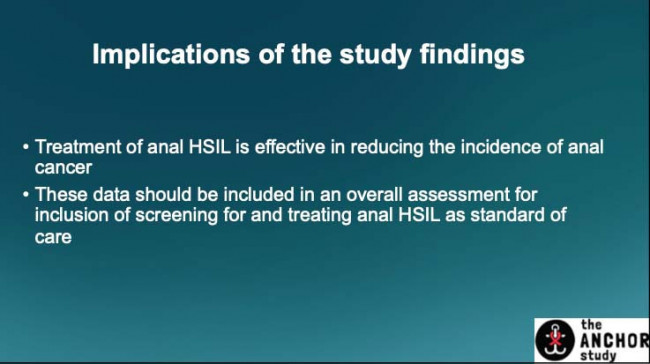Screening for precancerous anal cell changes and treating them early lowers the risk for progression to anal cancer in people living with HIV, according to long-awaited results from the ANCHOR study presented at the Conference on Retroviruses and Opportunistic Infections (CROI 2022).
“This is the first demonstration that screening and treatment reduces the risk of anal cancer,” said ANCHOR lead investigator Joel Palefsky, MD, of the University of California at San Francisco. “I think the data support inclusion [of screening and treatment] in the standard of care for people with HIV over 35.”
Anal cancer is uncommon in the population at large, but rates have been rising for both men and women since the 1970s, according to Palefsky, who established the world’s first clinic devoted to anal cancer prevention in 1991.
Like cervical cancer, anal cancer is caused by human papillomavirus (HPV), one of the most prevalent sexually transmitted infections. Most people acquire one or more types of HPV soon after they become sexually active. The virus triggers abnormal cell changes that can progress to precancerous dysplasia (known as high-grade squamous intraepithelial lesions, or HSIL) and invasive cancer.
The incidence of anal cancer is substantially higher for people living with HIV, for whom it is the fourth most common cancer, according to Palefsky. Previous research has shown that HIV-positive people have more types of HPV, are less likely to naturally clear the virus and experience more rapid progression to HSIL and cancer. Even people who are on effective antiretroviral treatment and have a high CD4 count can develop anal dysplasia and cancer. But unlike cervical cancer, anal cancer is not considered an AIDS-defining illness. Men who have sex with men are especially prone to anal cancer; other groups at risk include older individuals, women with cervical cancer and people with compromised immunity for other reasons.
Widespread screening and early treatment of precancerous lesions have dramatically lowered the prevalence and mortality of cervical cancer since the 1950s. But this is not the standard of care for people at risk for anal cancer. The reason, Palefsky said, is lack of evidence that it would work. Many at-risk people have multiple precancerous lesions, clinicians may miss or inadequately treat lesions and new lesions often arise after treatment, leading to what Palefsky termed “anal whack-a-mole.” What’s more, he previously told POZ, “If a woman has [cervical] HSIL, you can remove a large portion of the cervix. But you can’t do that in the anal canal, obviously.”
The ANCHOR—or Anal Cancer HSIL Outcomes Research—trial (NCT02135419) was designed to address this question. The study aimed to determine whether treating anal HSIL early can reduce the incidence of anal cancer in people living with HIV and whether doing so is safe. It also looked at quality of life and is creating a data and specimen bank to aid further research into factors that contribute to disease progression.
The study, funded by the National Cancer Institute’s AIDS Malignancy Consortium, enrolled people with HIV ages 35 and older in 15 cities across the United States. At study entry, they were screened for HSIL using anal Pap smears (cytology) and a technique called high-resolution anoscopy, in which a magnifying scope is used to examine the anal canal. If HSIL was suspected, a biopsy sample was collected for analysis.
Participants found to have HSIL were randomly assigned to receive immediate treatment or active monitoring. Those without HSIL returned for repeat monitoring every six months or more often if they were deemed to be at higher risk. People found to have anal cancer at any point were referred for further evaluation and treatment.
The most common treatments were electrocautery or infrared coagulation, two methods that use electricity or heat to burn off abnormal lesions. Other treatments included topical imiquimod or 5-fluorouracil cream or, in the most adavanced cases, surgery.
A total of 10,723 people with HIV were screened between September 2014 and August 2021. More than half (53% of men, 46% of women and 63% of transgender people) were found to have HSIL at study entry, and 17 were diagnosed with preexisting anal cancer. The prevalence of HSIL was about what was expected for men, but it was higher than expected for women, a group that mostly hadn’t been screened before, Palefsky noted.
Of this group, 4,446 people with HSIL were randomly assigned to the immediate treatment arm (2,227 people) or the active monitoring arm (2,219 people). The median age of the randomized participants was 51, and they had been living with HIV for a median of 17 years. A large majority (80%) were men—mostly gay or bisexual—16% were women and about 3% were transgender. About one third were white, 42% were Black and 16% were Latino. One third were current smokers, a known risk factor for anal cancer. More than 80% were on antiretroviral treatment with an undetectable viral load, and the median CD4 count was approximately 600.
The trial was halted ahead of schedule in October 2021 after an interim analysis showed that screening and early treatment confers a clear benefit: Removing HSIL significantly reduced the chances of progression to anal cancer. A data safety and monitoring board recommended that everyone in the monitoring arm should be offered treatment, and participants will continue to be followed.
Nine people in the immediate treatment arm and 21 people in the active monitoring arm were diagnosed with invasive anal cancer, meaning screening and treatment reduced the risk by 57%. The anal cancer incidence was 173 cases per 100,000 person-years of follow-up in the immediate treatment group compared with 402 cases in the monitoring group. Among those diagnosed with anal cancer in both groups, most were at an early stage.
Over the course of the study, 86% of participants received one type of treatment, 10% received two types and about 2% received three or four types. Treatment was generally safe and well tolerated. Just seven people in the immediate treatment group and one in the monitoring group experienced serious adverse events related to biopsy or treatment procedures.
“ANCHOR data show for the first time that, like cervical cancer, anal cancer can be prevented even in high-risk populations, such as people living with HIV, who often have HSIL that can be difficult to treat,” Palefsky said in a UCSF press release issued when the study was stopped. “Although the study was performed in people living with HIV, the results suggest that anal cancer prevention could be similarly possible in other groups known to be at increased risk of anal cancer, including women with a history of vulvar or cervical cancer, men who have sex with men who are HIV-negative and men and women who have immunosuppression for reasons other than HIV infection.”
Implications for People Living With HIV
These findings support the inclusion of routine screening and early HSIL treatment as part of the standard of care for people living with HIV, Palefsky said.

From Palefsky et al, CROI 2022, abstract 106LB
What’s more, the results support insurance coverage for these procedures. “This means people with HIV can now have their insurance cover anal cancer screening with anal Pap smears and high-resolution anoscopy as well as treatment if high-grade lesions are found,” Jeff Taylor, a longtime advocate who has had anal cancer himself, told POZ. “Until now, you had to be lucky or privileged enough to live someplace with progressive and knowledgeable HIV providers willing to perform these procedures and have insurance that would pay for it.”
But the lack of clinicians who are trained to perform high-resolution anoscopy remains a barrier. There is a need for biomarkers to help predict who is at greatest risk for HSIL progression—or for regression without treatment. And there is “room for improvement” in the treatment of anal HSIL, Palefsky said.
A digital rectal exam can detect abnormal growths, and Palefsky recommended this as a first step for people living with HIV. When the availability of high-resolution anoscopy is limited, he said that people who have symptoms of anal HSIL or cancer, including pain, bleeding and new lumps, should be prioritized first. The next priority should be older individuals and those with a low current or nadir (lowest-ever) CD4 count.
ANCHOR participants had been living with HIV for an average of 17 years, and the risk of anal cancer increases with age. “Anal cancer will increase as the HIV population ages,” Palefsky said. “This is a great time to train the workforce and get them ready for when that inevitable increase happens.”
While these results are good news for people at risk for anal cancer, preventing HSIL in the first place would be even better. The Gardasil 9 vaccine protects against nine high-risk HPV types that cause cancer or genital warts. The vaccine is recommended for girls and boys at age 11 or 12, with catch-up vaccination through age 26. The Food and Drug Administration has approved the vaccine for people up to age 45. By that time, most people have already contracted HPV, but some individuals (for example, a middle-aged person reentering the dating scene after a long-term monogamous relationship) could still benefit.
Click here to read the study abstract.
Click here for more reports from CROI 2022.
Click here to learn more about anal cancer.
Click here for a POZ feature about cancer in people living with HIV.







2 Comments
2 Comments